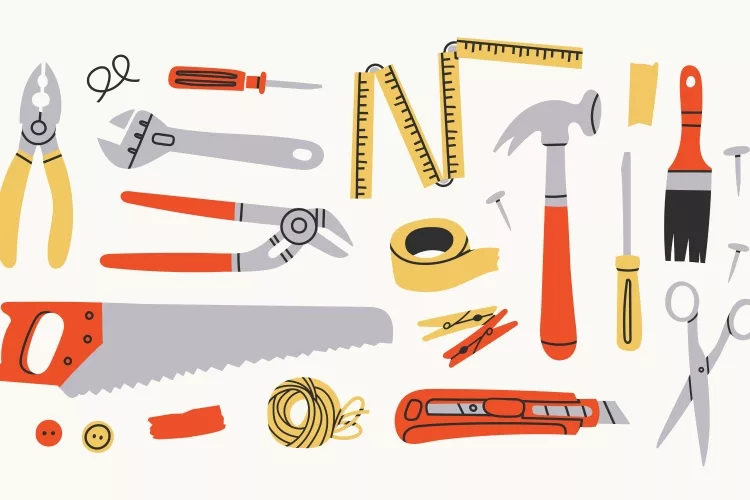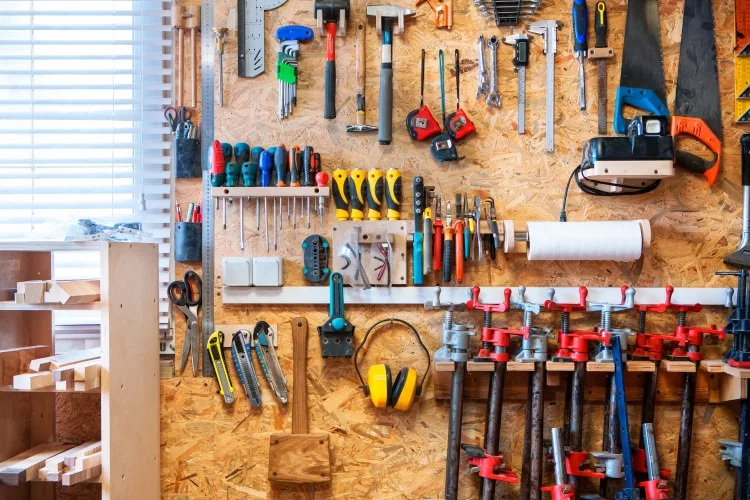All Mechanic Tools Names and Their Functions
by Chris Lewis.
To fix a car, you'll need four things: Knowledge, ability, tools, and equipment. You can have all the technical expertise and capabilities in the world, but you won't be very
effective unless you have the right tools.
But, let's be honest, you're just interested in the tools. Isn't it?
However, figuring out which tool to use can be difficult, especially if you're a beginner mechanic. Essential vehicle repair tools exist. Intermediate equipment allows you to work on more advanced operations.
Contents
In addition to typical garage equipment and tools, qualified technicians use advanced tools for particular desired work. Using the appropriate tool will help your task go faster, simpler, and reduce injuries.
You don't need to be intimidated by the variety of tools accessible. We've categorized car tools into the following groups:

Summary Table for Mechanic Tools Names
| Hand Tools | Many of these fundamental tools are likely already in your possession. Hammers, wrenches, pliers, and other tools are among them. We'll demonstrate how to utilize these popular tools for everyday maintenance as well as complicated repairs. |
| Equipment for the Garage | Lights, Creepers, and other items in the garage assist mechanics in working comfortably. This equipment also aids in the prevention of injuries, damages, and accidents. |
| Diagnostic Equipment | Before you start resolving a car issue, you must first figure out what's causing it. Diagnostic tools connect to your car's electrical systems, assess tire pressure, and offer other essential help. |
| Safety Tools | Chemicals and components in your vehicle might be hazardous. We will show you what safety equipment you'll need when servicing your car. |
| Component Loosening and Removal Tools | To remove and access various pieces, you'll frequently require specialized tools. Furthermore, with time, several engine components might become locked together. |
| Cleaning Equipment for Your Car | Maintain the appearance of your vehicle without breaking the bank. Various tools will help you clean your car and save it from road damage with the gear you'll need. |
Auto Mechanics' Must-Have Personal Protective Equipment
When working as an auto mechanic, it's critical to think about safety. Whether you're working in a traditional vehicle repair business or on your own, safety should always come first.
Gloves


Gloves keep mechanics' hands clean when working with grease, oil, or other nasty materials. As an auto technician, you need to invest in two types of gloves. These gloves are both disposable and non-disposable.
Shield for the Face
- #PreviewProductRating
- Bestseller No. 1
- Bestseller No. 2
- Bestseller No. 3
- Bestseller No. 4
- Bestseller No. 5
Many gases and abrasive clouds are emitted into the air during various mechanical activities. These gases endanger human health. During such procedures, it is critical to keep your face protected. Consider purchasing extra filters if you purchase a face shield with detachable filters.
Safety Shoes
- #PreviewProductRating
- Bestseller No. 1
- Bestseller No. 2
- Bestseller No. 3
A work boot is the most significant safety shoe to wear. As the name implies, safety boots provide optimum protection for your legs against cuts, scrapes, and burns. Steel-toed safety footwear should always be purchased.
Hand Cleanser
- #PreviewProductRating
- Bestseller No. 1
- Bestseller No. 2
Before beginning any mechanical job, keep in mind that dirt and grits are unavoidable. An entry-level task, such as changing your oil, might leave your hand smelling terrible and dirty.
You could consider using gloves to protect your hands, but keep in mind that they can rip off.
The following is a list of auto mechanic tools and equipment that every technician should be familiar with:
Hand Tools

Typically these are essential tools that may be used in several situations. These are little tools that can be operated with just one hand, as the name indicates. Hand tools, in most circumstances, are powered by elbow grease and do not require electricity.
The majority of the tools listed here are available in several versions. Pliers, for example, can feature a locking joint, a slip joint, or another form of joint. Understanding how each tool works can help you choose the best one for your requirements.
Here's a deeper look at some typical auto repair hand tools:
Wrenches
- #PreviewProductRating
- Bestseller No. 1
- Bestseller No. 2
- Bestseller No. 3
The wrench is the most important tool on this list.
A wrench is a must-have item for any toolbox. We propose investing in tools made of chrome-vanadium alloy since they will last a lifetime.
If you must choose between metric and standard wrenches, go with the metric option. It's nice to have both, but we don't utilize our regular settings very often.
They range in size from 6mm to whatever insane size you can dream of in metric. Having up to 21-24mm is usually sufficient.
Ratchets
- #PreviewProductRating
- Bestseller No. 1
- Bestseller No. 2
- Bestseller No. 3
Ratchets come in three sizes: ¼" (small), ⅜" (medium), and ½" (large).
Some sets include all three, two, or just one size. Ratchets and wrenches are included in some kits. Get at least a big and a little ratchet set with the basic sockets, as they will be the ones you use the most.
Ratchets provide you with the flexibility, speed, and accuracy to work. One of the finest buys you can make for your toolbox.
You'll need sockets ranging from 6mm to 24mm, as well as a single 32mm.
Screwdrivers
- #PreviewProductRating
- Bestseller No. 1
- Bestseller No. 2
- Bestseller No. 3
A good pair of screwdrivers is a must-have in every well-stocked toolbox.
There are a variety of forms to choose from, but the most popular are flat, Torx, Allen, and Phillips.
The most common shapes and sizes of screwdriver heads are included in most ratchet sets.
At the very least, purchase some stubbed ones, which are excellent for employing in tight spots, and some standard length ones.
Pliers
- #PreviewProductRating
- Bestseller No. 1
- Bestseller No. 2
A pair of pliers should be in every mechanic's toolkit. Pliers are essential equipment for technicians for fixing brakes, replacing hoses, and working on other car components. They're also used to compress and bend materials, as well as to hold heated components.
Bent nose pliers, diagonal pliers, straight nose pliers, slip-joint pliers, lineman's pliers, and Fencing pliers are only a few examples. It's also available in a variety of lengths, forms, and sizes. In any event, make sure you have a variety of pliers on hand because they each serve a different purpose.
Crimper for wire terminals
- #PreviewProductRating
- Bestseller No. 1
- Bestseller No. 2
- Bestseller No. 3
A crimper is a tool that connects two metal parts. The wire is inserted into the connector, which is then inserted into the crimping equipment slot.
Crimping provides the wires with a professional finish, which significantly increases their safety. They come in handy when changing wire terminals in cars.
Wire Connectors in a Set
- #PreviewProductRating
- Bestseller No. 1
- Bestseller No. 2
- Bestseller No. 3
- Bestseller No. 4
- Bestseller No. 5
These little plastic boxes are essential for keeping the electrical systems of your cars in good working order. Wire connectors link two wires safely and securely. They keep wires from coming into touch with each other. The likelihood of a power surge or any other electrical failure is significantly decreased.
Wire connections are often low-cost. When they're worn, they leave a dark residue. When performing repairs, you should generally replace any wire connections you come across.
Electrical Fuses Set
- #PreviewProductRating
- Bestseller No. 1
- Bestseller No. 2
- Bestseller No. 3
The blown fuses can create issues with your car's electrical system. Fortunately, changing fuses is a simple process. You may get a fuse box with five, ten, or even twenty-five fuses. To determine the precise size of your car, see your owner's handbook. The most frequent fuses are medium-sized ones.
GARAGE TOOLS FOR YOUR HOME

We've all heard of the old-fashioned method of working on a car at home: lay a piece of cardboard on the garage floor and slide underneath it. Isn't banging your head or scratching your arm just part of the car-repair process?
That isn't the case. A few pieces of equipment can help make at-home car repair more accessible, safer, and enjoyable. Here's a rundown of everything you'll need to turn your garage into a car-maintenance paradise.
Jack and Jack stands
- #PreviewProductRating
- Bestseller No. 1
- Bestseller No. 2
- Bestseller No. 3
Lifting and suspending vehicle wheels are required for more than half of all suspension work. Aside from suspension work, there is another type of automotive maintenance that necessitates the vehicle being lifted.
Jacks lift vehicles, and the vehicle is supported with jack stands to keep it from sliding. Don't skimp on the quality of your jack and jack stands by selecting the cheapest option. A low-quality jack might fail, causing damage to the car as well as personal injury.
Ramps
- #PreviewProductRating
- Bestseller No. 1
- Bestseller No. 2
Car ramps can be used instead of jacks. They're usually offered in pairs and are composed of heavy-duty plastic. You drive forward after placing a little ramp beneath each of your front tires. Then, behind the back wheels, you'll put wheel stoppers.
Ramps do not, however, provide as much lift as a jack, but they should be enough for an oil change and other routine procedures. Ramps, on the other hand, restrict the wheels from moving, limiting some forms of maintenance.
Creeper
- #PreviewProductRating
- Bestseller No. 1
Get rid of the cardboard. Working underneath your car using a creeper is considerably safer and more pleasant. Creepers are wheeled sleds that support your body and make it easy to move about underneath your car.
The majority of creepers can be adjusted. The backing of creepers is usually cushioned or soft plastic, and it adapts to your body.
Aside from providing comfort, the top mechanic's creepers make car maintenance much safer and more accessible. You won't have to worry about scratching your back on the rough floor. You'll also be less likely to sustain scratches, rips, or other injuries.
Flashlight
- #PreviewProductRating
- Bestseller No. 1
- Bestseller No. 2
When working on your engine, use a portable light source. Choose one with a long-lasting plastic casing. To the touch, the metal casing will be hot. You may hang the light from the inside of your open hood if the housing includes a hook.
Final Thoughts for Mechanic Tool Buyers
Auto repair companies require various tools and equipment regardless of the services you wish to provide as an auto mechanic. The above list of auto mechanic tools and equipment includes must-have mechanic tools that both individual auto technicians and auto garages should have to solve any vehicle issues.
In any event, some of these tools are sophisticated, and only skilled mechanics utilize them. Regardless, any mechanic, do-it-yourselfer, or car enthusiast should be familiar with these tools and utilize them.
As needed, add tools to your collections. If buying a new tool is the best approach to tackle an issue, don't hesitate to do so. Many people accumulate their tool collection over time by purchasing tools as required as car problems arise.
 |
 |
 |
 |

About Chris Lewis.
Chris Lewis is a passionate individual with a deep affinity for the world of automobiles. From a tender age, his fascination with cars was nurtured by his father, a seasoned mechanic based in the vibrant city of San Francisco. Growing up under the watchful guidance of his skilled father, Chris developed an early aptitude for all things automotive.
Thoughts on "All Mechanic Tools Names and Their Functions"
 |
 |
 |
 |
Get FREE Filters now. Or latest free tools from our best collections.
Disable Ad block to get all the secrets. Once done, hit any button below
 |
 |
 |
 |







































